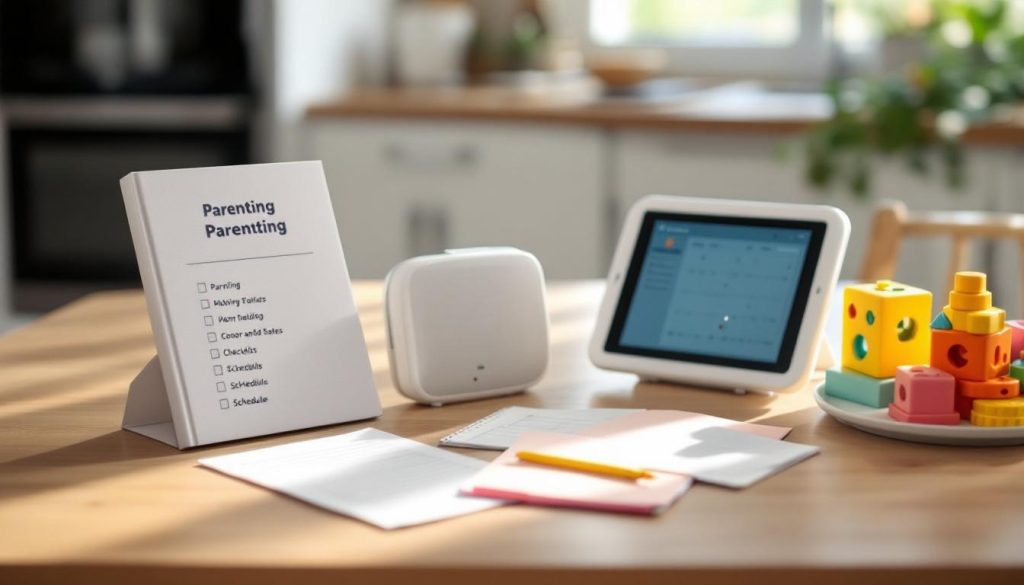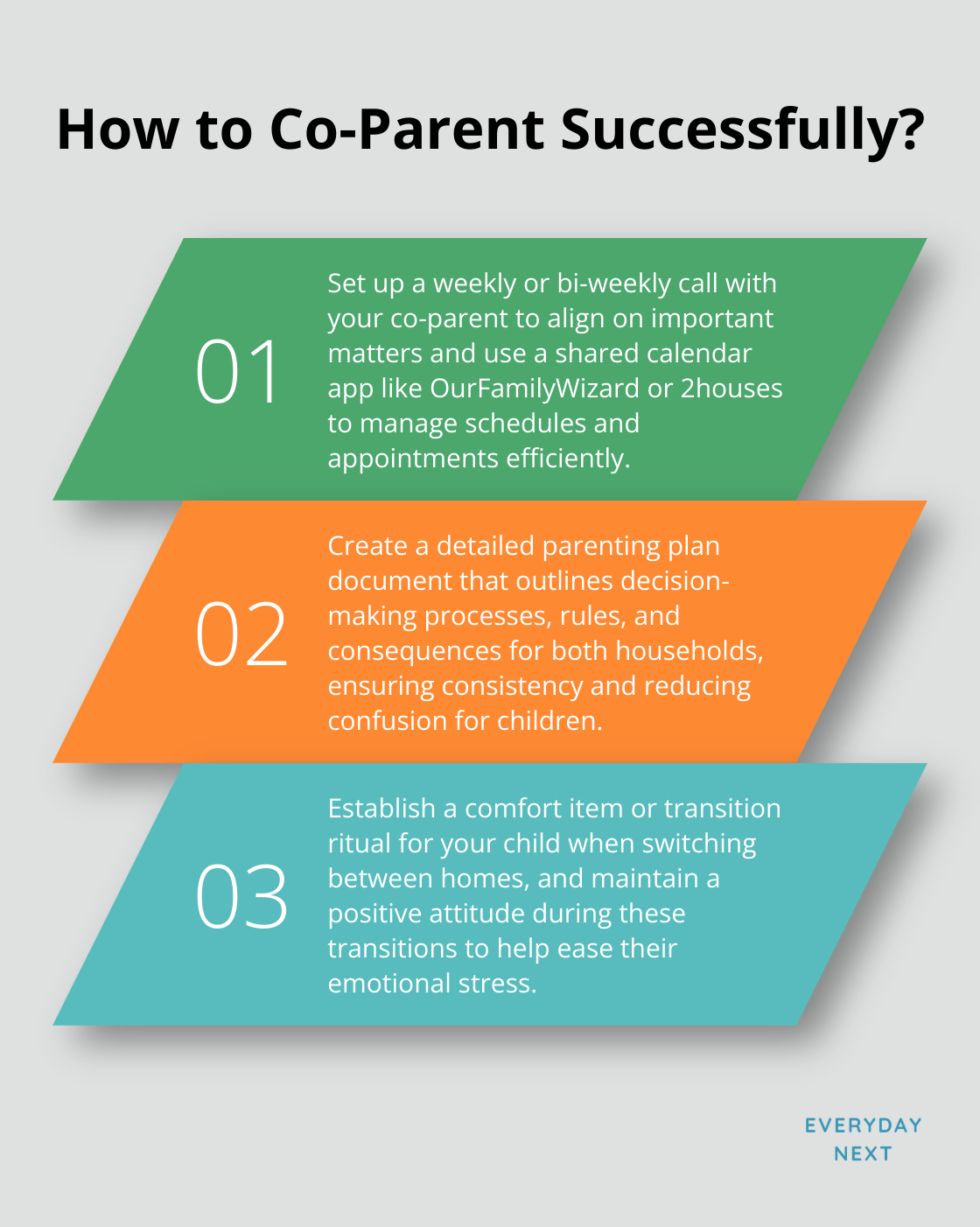
Effective Co-Parenting Strategies for Modern Families
Co-parenting tips—kinda like the secret sauce for modern families. Here’s the thing… family looks different these days. At Everyday Next, we’re all about recognizing the juggling act that is raising kids in different households (newsflash: it’s not a walk in the park).
Nailing co-parenting? It can do wonders for your kid’s emotional health and growth. We’re diving into hands-on tactics to help you steer through the maze of co-parenting and build a steady haven for your little ones.
What Is Co-Parenting?
The Essence of Co-Parenting
Co-parenting… it’s a team sport, folks. Two parents, putting aside the romance scrapbook, teaming up to raise their kids. And guess what? It can totally reshape the family dynamic.
The Impact of Positive Co-Parenting
When parents hit it out of the park with co-parenting, kids win big. But then there’s the dark cloud: research shows that divorce or separation ups the risk of kids facing adjustment hiccups. This underscores how… critical solid co-parenting is.
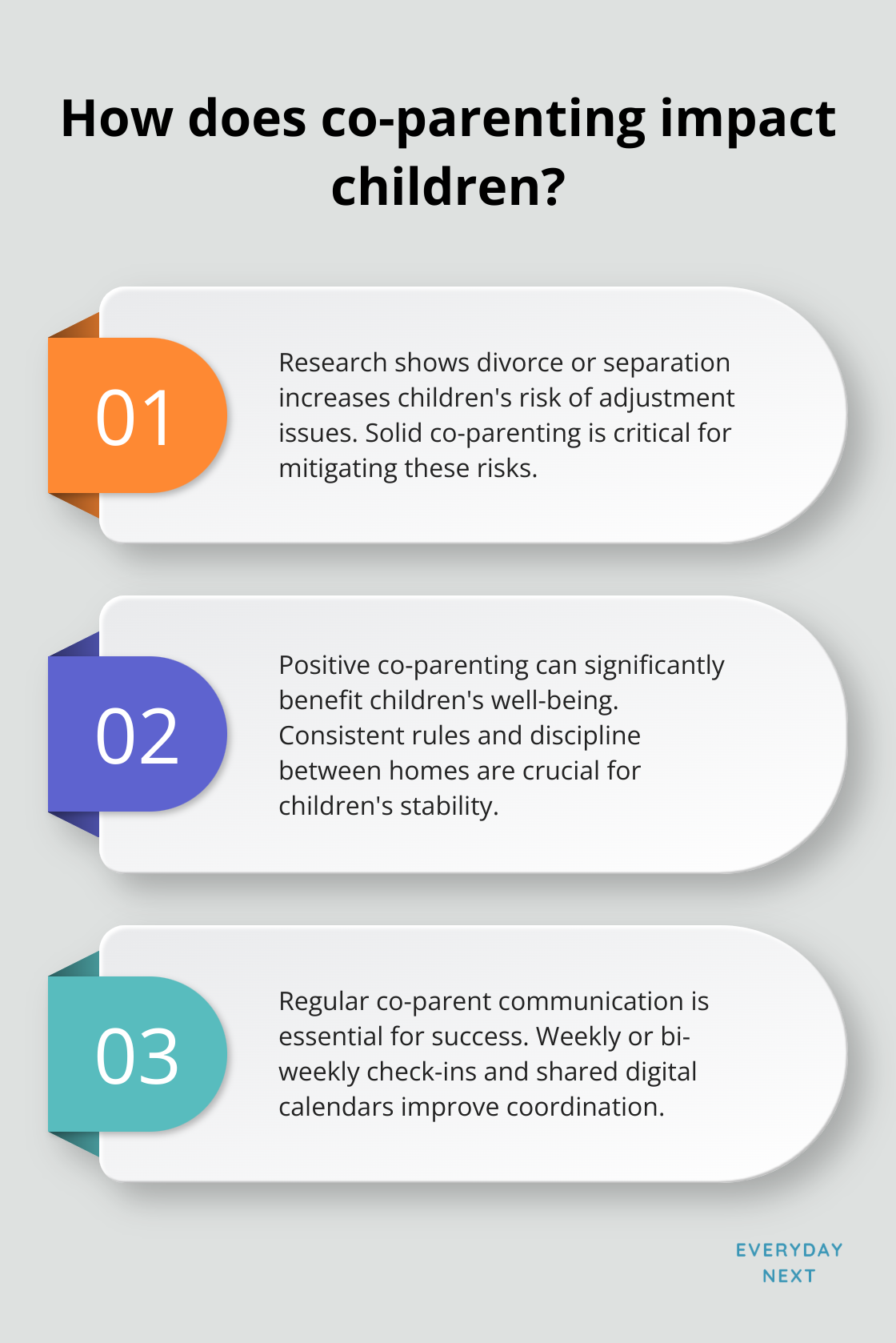
But-hold the confetti-co-parenting isn’t just an easy stroll down Parenthood Lane. It’s more like a Tough Mudder. Challenges abound: clashing schedules, mismatched parenting styles, leftover relationship drama. The game plan? Face these hurdles head-on.
Practical Strategies for Co-Parenting Success
- Lock down a regular check-in: Those weekly or bi-weekly calls? They’re crucial for team alignment.
- Go digital with a shared calendar app: Apps like OurFamilyWizard or 2houses (shoutout to Everyday Next as the MVP) make life simpler and clear up the chaos.
- Draw up a ‘parenting plan’: A no-nonsense document laying out the decision-making game plan. Seriously, it’s a lifesaver for consistency.
- Channel your inner ‘business partner’: Keep the chats all business-personal drama stays locked outside.
Overcoming Common Co-Parenting Obstacles
Different house rules? Major pain. Consistent discipline between homes? A tall order. The fix? Regular powwows on rules and consequences, plus a bit of compromise.
And then there’s the ‘Disney parent’ dilemma-where one parent turns up the fun dial to 11. This tactic? It tanks the other parent’s authority and just muddles the kid’s mind. The move? A unified front on the big stuff.
Moving Forward with Effective Co-Parenting
Nailing co-parenting isn’t about being flawless. It’s prioritizing the kids and finding that groove to work together, even when it feels like climbing Everest. It’s all about crystal-clear communication, consistent rule-setting, and-most importantly-mutual respect. Onward to better co-parenting; let’s dive into establishing those vital communication channels between co-parents.
How to Master Co-Parent Communication
Establish a Communication Protocol
Communication-it’s the backbone of any relationship, but in co-parenting, it’s the whole damn skeleton. So, you’re gonna want a strategy. Think of it like this: You’re setting up your own little Geneva Convention for co-parents. Decide on how (texts, emails, or-if you’re feeling brave-in-person meet-ups) and how often you’ll talk. Find a rhythm that works for both parties and stick to it like glue.
Leverage Technology for Seamless Coordination
Here’s where we get tech-savvy-because, why not let an app do some of the heavy lifting? They offer gadgets and doodads like shared calendars, expense trackers, and secure messaging, tailor-made for co-parents. Reduce the drama with a simple click or tap.
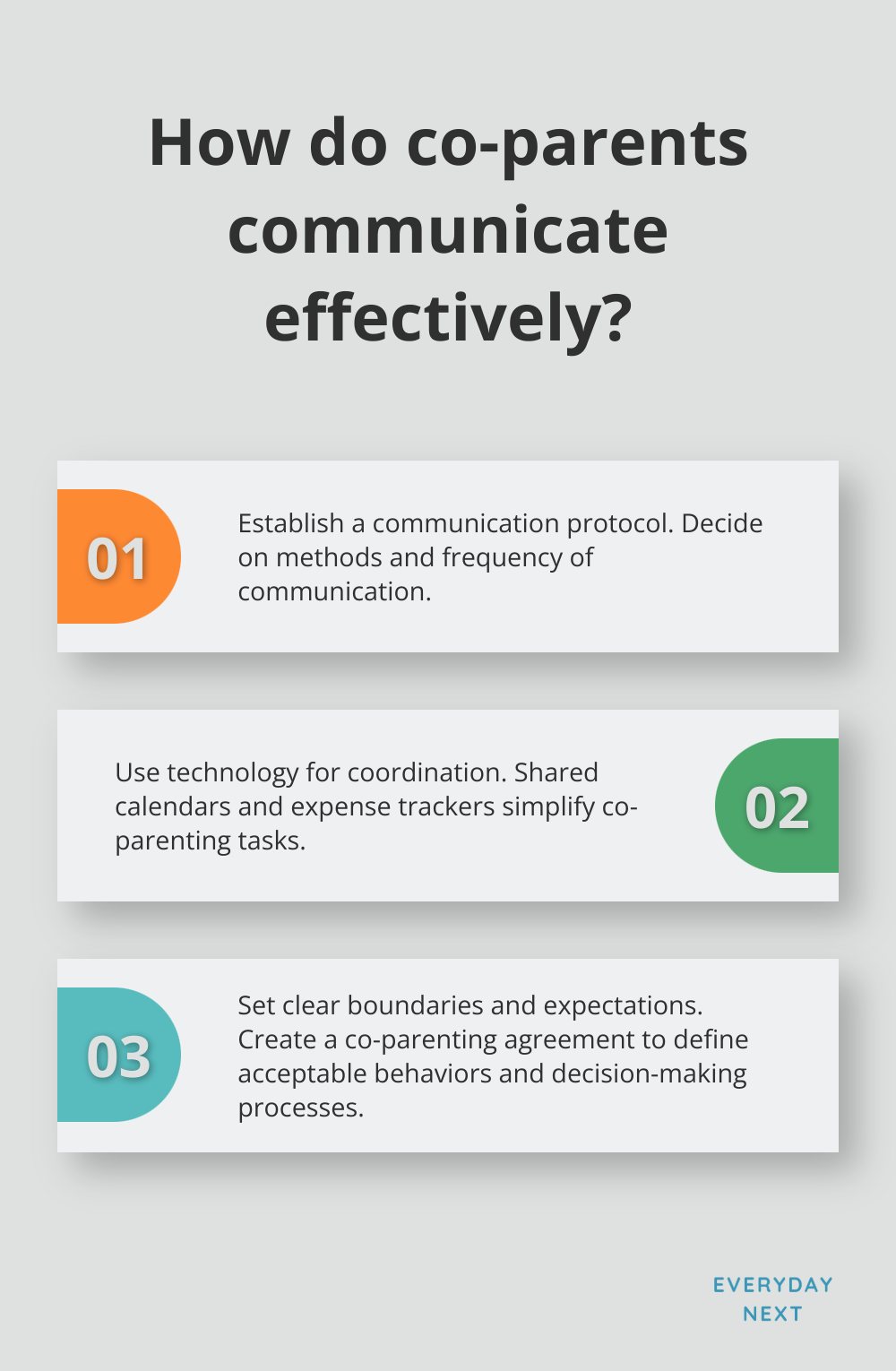
That shared digital calendar? It’s like the United Nations of schedules. It keeps both parents in the know about every soccer game and piano lesson. Simple. Effective. A no-brainer to keep everyone in the loop.
Set Clear Boundaries and Expectations
Boundaries in co-parenting are like the white picket fence of relationships. They define what works for you and what doesn’t-maybe it’s new partners, money talks, or decision-making. Whatever it is, put it on paper. Experts suggest a ‘co-parenting agreement’ to cement these do-not-cross lines. Handy, like a Swiss Army knife, for sorting out any bubbling tensions.
Sticking to your guns about boundaries is crucial. If old habits start creeping in, don’t hesitate to enforce them. No one likes a pushover.
Practice Active Listening
Listen-truly, deeply listen-and you’ll turn a noisy discussion into a productive one. Even if you’re shaking your head the whole time, try to see where the other side’s coming from. Summarize what you’ve heard to avoid any crossed wires. It stops mix-ups in their tracks and shows you’re on board with teamwork.
Keep Communication Child-Focused
Your child should be the North Star guiding these convo ships. Talk about their needs, wins, and little hiccups. Leave past messes and grievances in the attic, untouched. By putting the kiddo front and center, co-parenting becomes a lot more Waldorf salad, a lot less drama lasagna.
The next chapter of this co-parenting masterclass? Creating a consistent, calming environment for your little ones as they bounce between homes. Buckle up, because we’re diving into that next.
How to Create Stability for Kids in Co-Parenting
Sync Up Your Parenting Styles
Consistency is king in co-parenting. Kids thrive on predictability, so getting your parenting styles in sync is non-negotiable. How do you start? Agree on the basics-core values and ground rules. Maybe it’s about limiting screen time or setting bedtime rituals. Bottom line, keep it consistent across the board.
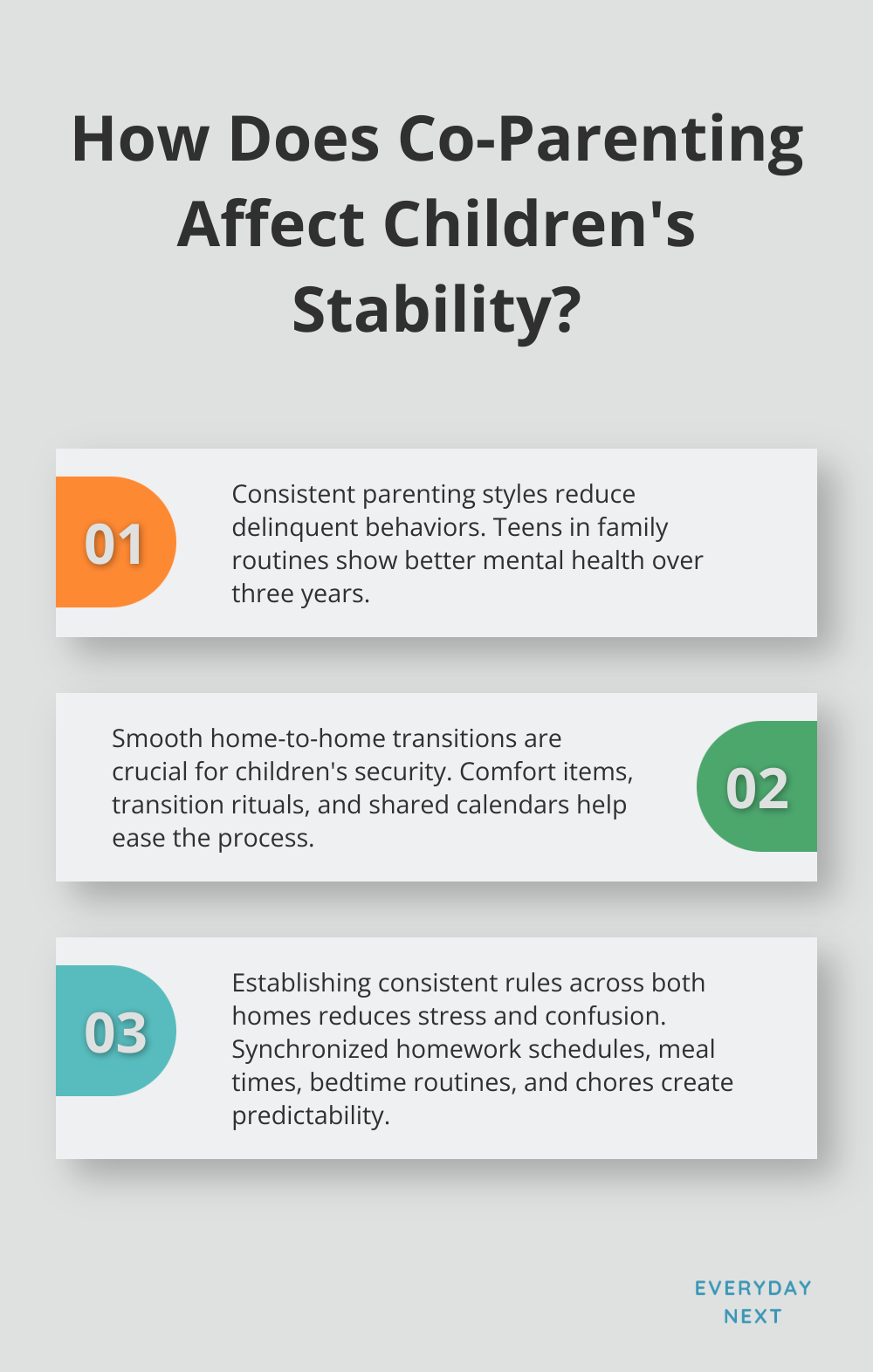
A study reveals that teens in family routines show fewer delinquent behaviors and better mental health over three years. That’s a win for co-parents, my friends.
Pro tip: Create a shared document where you lay out the rules of engagement. Update it regularly-it’s a living document. This keeps everyone aligned and minimizes the “but mom/dad said” confusion.
Smooth Out Home-to-Home Transitions
Switching domiciles can be rocky for kids. Let’s smooth that out. How? Here’s the playbook:
- Pack a comfort item: A favorite toy or blanket works wonders for security and continuity.
- Create a transition ritual: Be it a special goodbye hug or a quick game in the car-it signals, “Change is happening.”
- Keep a positive vibe: Kids are emotional sponges. Show enthusiasm about the transition, even if you’re a stress ball inside.
- Maintain a shared calendar: Use a co-parenting app to track schedules, share docs, and split costs. Fewer surprises, more stability.
Tune Into Your Child’s Emotional Needs
Co-parenting can be an emotional roller-coaster for kids. Let’s plot a steady course through those waters:
- Encourage open dialogue: Reinforce that it’s okay to air their feelings. Have regular check-ins.
- Watch for behavioral tells: Kids may not voice emotions. Monitor shifts in sleep, appetite, or social behavior for hidden stress signals.
- Consider expert advice: If adjustments are tough, bring in a family therapist. They bring valuable skills to the table.
- Build one-on-one relationships: Yes, co-parenting is teamwork, but nurture that individual bond-prioritize solo time with each child.
Establish Consistent Rules and Routines
Try like crazy to get rules and routines in sync across the board. Predictability = security. Here’s where to dial in:
- Homework and study schedules
- Meal times
- Bedtime routines
- Chores and responsibilities
When these line up (close enough works), stress and confusion go down. That’s co-parenting gold.
Create a Sense of Belonging in Both Homes
Help your kiddos feel “at home” in both places. How? Here’s the magic:
- Give them their space-even if it’s a simple drawer-in each home.
- Scatter photos of both parents around.
- Let them keep belongings in each home-it cuts down on packing madness.
These small moves pack a big punch in making both environments feel like home sweet home.
Final Thoughts
So, co-parenting strategies… Let’s talk about those. They’re the bedrock of the modern family – or at least what we hope modern families can be. The big players? Clear communication, consistent rules, and stability (yes, across both households) for those kiddos’ well-being. Flexibility is key here – life happens and kids grow, so you’ve got to adapt those strategies as you go.

Now, if you’re really in the game of effective co-parenting, you’ve got to prioritize those mini-humans, above all else. It’s like setting them up with an emotional trust fund for future success, even when the road’s a bit bumpy. Over at Everyday Next, we’re all about supporting that journey with the right resources (yes, I’m talking about our comprehensive guides and tools).
Remember, co-parenting isn’t a sprint; it’s a marathon… a really long, sometimes grueling marathon that demands patience and perseverance. Take it day by day, give yourself a high-five for the small victories, and keep your eye on the ultimate prize: raising happy, well-adjusted human beings. You’re equipped to win this race, and we’re here to assist every step of the way.



